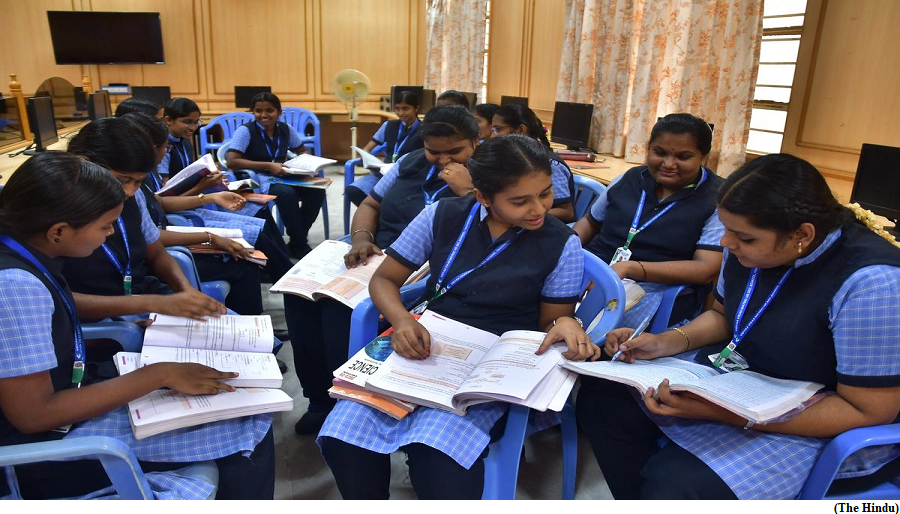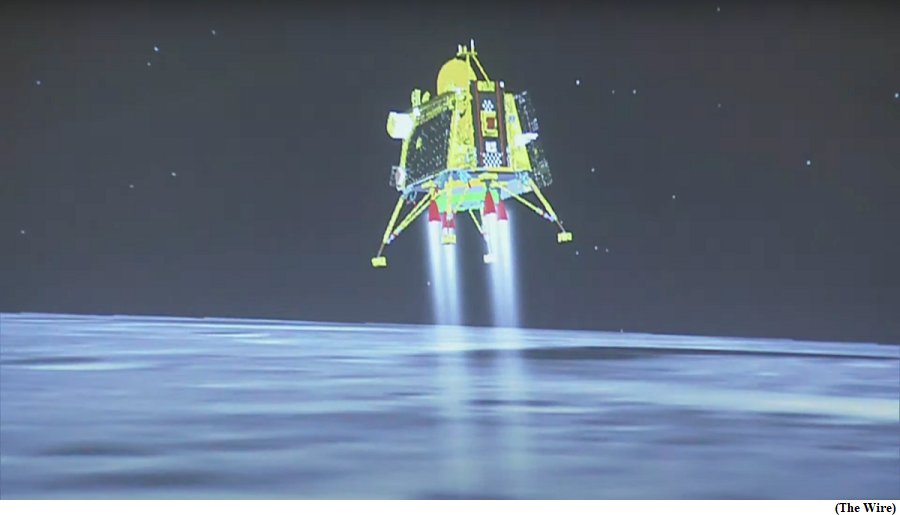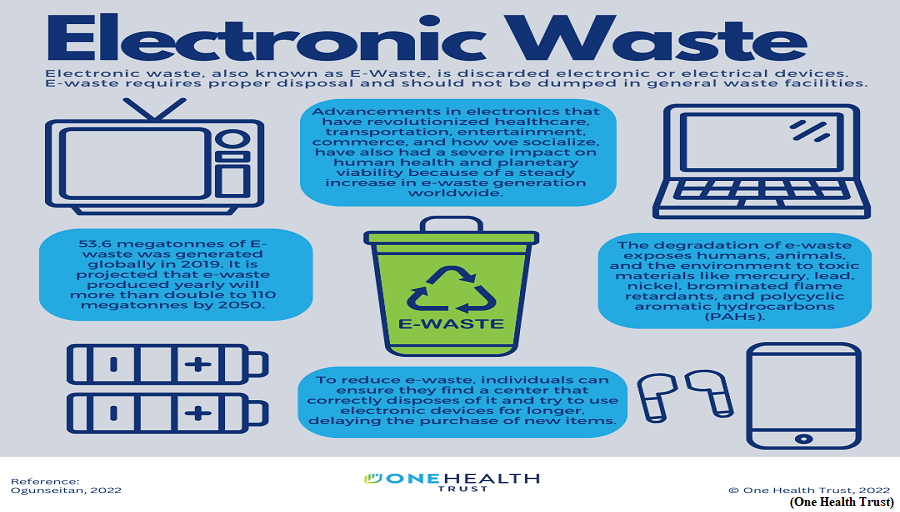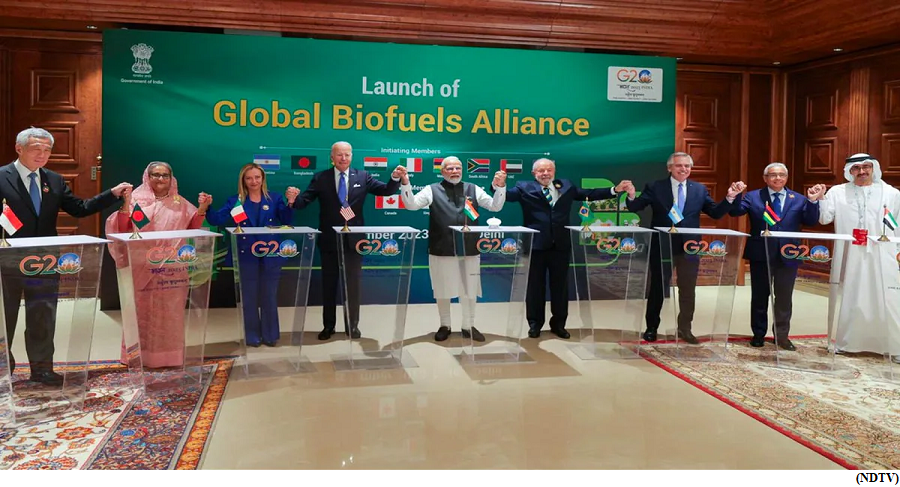Education Ministry asks States to bring all data under one platform (GS Paper 2, Education)

Why in news?
- Under the National Digital Education Architecture (NDEAR), the Education Ministry is pushing States to open Vidya Samiksha Kendras (VSKs), which are data repositories that will have data from all schemes run by the Ministry.
This will include regularly updated data from
- the PM-POSHAN mid-day meal programmes;
- teacher training data from the National Initiative for School Heads’ and Teachers’ Holistic Advancement portal;
- textbook content from the Digital Infrastructure for Knowledge Sharing;
- school dropout and attendance-related data on the Unified District Information System for Education (UDISE+);
- students’ learning outcomes from the National Achievement Survey; and
- Performance Grading Index which evaluates school education system at the State and Union Territory (UT) level.
About Vidya Samiksha Kendras (VSKs):
- Currently, at the Central level, a VSK is housed in the Central Institute of Educational Technology building on the National Council for Educational Research and Training (NCERT) campus, with multinational IT company Ernst and Young (EY) managing its operations.
- It is an open-source platform run on C-Qube software.
- EkStep Foundation, a non-profit organisation co-founded by former Chairman of Unique Identification Authority of India Nandan Nilekani, is on board in an advisory role for implementing the VSK project.
- This is in line with the National Education Policy (NEP)-2020 talking about developing operational standards for making data open source.
Funding:
- The Centre has allocated funds ranging from ₹2 crore to ₹5 crore to each State for adopting and establishing VSKs that include pre-configured open-source hardware and software as well as hiring human resources.
- States like Gujarat, Maharashtra, Odisha, and Jharkhand have already begun the process of setting up the tech platform.
- The idea of bringing all data on one platform is to employ analytics for correlation.
- For instance, in certain schools, Gujarat has employed biometrics to capture attendance patterns of students and teachers.
Way Forward:
- The idea of developing VSKs is also to map the school location layer with the population layer to assess the Gross Access Ratio, which can help plan for new schools, or for industry clusters to understand skilling requirements of the area, and help plan higher educational institutions based on demand and future scenarios.
What helped Vikram lander to soft-land on the moon
(GS Paper 3, Science and Technology)
Why in news?
- Chandrayaan-3 has created history by landing near the little-explored south pole of the Moon on August 23, 2023.

Chandrayaan-2:
- On July 22, 2019, India successfully launched Chandrayaan-2, the second mission to the moon. Twenty-two days later (August 14), after a series of orbit raising manoeuvres, the spacecraft finally escaped the earth’s gravity and followed a path towards the moon. Six days later, Chandrayaan-2 was successfully inserted into lunar orbit.
- Finally, on September 2, the Vikram lander separated from the Orbiter, performed two de-orbit manoeuvres and on September 6, began its descent to the moon’s surface.
- The descent went as planned up to an altitude of 2.1 km from the moon’s surface before communication from the lander to the ground stations was lost. The Vikram lander had apparently crash-landed on the moon.
Dr. V. Narayanan Committee:
- Soon a national-level failure analysis committee headed by Dr. V. Narayanan, Director of the Liquid Propulsion Systems Centre (LPSC), was formed with experts drawn from national institutes and ISRO to study the cause of failure and to propose necessary corrections.
- The committee pinpointed three crucial mistakes that had happened in succession resulting in the crash.
There are four important phases before the touchdown on the moon:
- the rough braking phase,
- the attitude-hold (orientation) phase,
- the fine braking phase, and
- the landing phase.
- During the rough braking phase, the velocity of the lander was successfully reduced to a maximum.
Issues with Vikram lander:
- The problem with the touchdown began when the Vikram lander entered the second phase, the attitude-hold (orientation) phase. During this phase, the thrust had to be maintained at half the level.
- The guidance system was supposed to have halved the thrust but it malfunctioned. At the end of the attitude-hold phase, the altitude and velocity were very different from the expected values. The guidance-system malfunction was the second crucial error.
- During the fine braking phase, the system was trying to correct the large errors. The large-scale corrections to velocity and altitude demanded large orientation manoeuvres.
- Changes to orientation are carried out by the control system, but unfortunately the control system was not designed to produce large changes.
The crash was caused by three mistakes;
- the thrust (dispersion level) was more than assumed for design,
- the flaw in the guidance system resulted in more thrust being given, and
- the rate restriction in the control system failed to make large-scale changes in the orientation.
Lesson for Chandrayaan-3 mission:
- Taking the learnings from Chandrayaan-2 failure, ISRO corrected for all the three major mistakes in the latest mission; the system was corrected to ensure extra dispersion does not happen, the guidance system was corrected, and the restriction in the control system was removed.
- In addition, other improvements suggested by the failure analysis committee were also incorporated in the Chandrayaan-3 mission. Extra fuel, sensors and stronger lander legs designed for higher landing velocity led to a net increase in the weight (about 250 kg) of the lander.
- Since Chandrayaan-3 was not carrying an orbiter like its predecessor, it became possible to accommodate the increased weight.
What should be done with electronic waste?
(GS Paper 3, Environment)
Why in news?
- The Indian Cellular and Electronics Association (ICEA) recently released a report on ‘Pathways to Circular Economy in Indian Electronics Sector,’ following a government effort with NITI Aayog to explore opportunities to harness e-waste.
- The report talks about changing the outlook on e-waste management to build a system where discarded electronics can have a new life, either by themselves, or by reintroducing components and precious metals into new hardware.
- There could be an additional $7 billion market opportunity in harnessing e-waste.

Does India have e-waste management?
- E-waste management is largely informal in India, as in the case of recycling. “Roughly 90% of collection and 70% of the recycling are managed by a very competitive informal sector”.
- The informal sector is good at salvaging older devices for parts and profiting from repairs with them. Then there are almost industrial hubs like Moradabad, where printed circuit boards (PCBs) arrive in the tonnes to have gold and silver melted out of them and sold.
- The Union Government notified the E-Waste (Management) Rules, 2022 in order to digitise the process and provide more visibility to the movement of e-waste in the economy. The level of e-waste may grow, too, as phones get cheaper and people use them more on the back of cheaper data plans.
Why is a circular economy important?
- Demand for electronics is growing across all price segments, even as the production of these devices entails the use of scarce elements and high emissions. Instead of merely salvaging these parts, a circular economy seeks to bring them back into the electronics ecosystem.
- There needed to be a policy push to encourage manufacturers to reuse old components.
- By 2019, China ensured that 5% of their secondary raw material went into manufacturing of new products. By 2030, they are targeting 35%.
How can e-waste be recycled?
- The ICEA report suggests public-private partnerships to distribute the costs of setting up a sprawling “reverse supply chain,” an expensive prospect that envisages collecting devices from users, wiping them clean of personal data, and passing them along for further processing and recycling.
- It also suggests launching an auditable database of materials collected through this process, and creating geographical clusters where these devices come together and are broken apart.
- A key recommendation is to incentivise so-called ‘high yield’ recycling centres. Facilities that recycle are generally not equipped to extract the full potential value of the products they handle, for instance extracting minute but precious amounts of rare earth metals in semiconductors.
- The IT Ministry launched a scheme in April 2022 to cover 25% of the capital expenditure on such facilities.
What are the challenges?
- Beyond the large informal sector that is hard to track or hold to environmental norms, there are basic challenges.
- For instance, a whopping 200 million devices are estimated to be lying at consumers’ homes, who don’t hand them in for recycling after they stop using them.
- Building recycling plants on a large scale also requires more than the initial capital costs.
- Extracting the full value of electronics is capital intensive, and will require better clustering of materials, and a viable business model. The challenge is to be able to replicate the success of the informal sector in a formalised and reliable way.
Global Biofuels Alliance (GBA) announced at G20 event
(GS Paper 3, Environment)
Why in news?
- Global energy sector has witnessed a historic moment with announcement of the Global Biofuels Alliance (GBA) by Indian Prime Minister on the sidelines of the G20 Summit.

What is GBA?
- GBA is an India-led Initiative to develop an alliance of Governments, International organizations and Industry to facilitate adoption of biofuels.
- Bringing together the biggest consumers and producers of biofuels to drive biofuels development and deployment, the initiative aims to position biofuels as a key to energy transition and contribute to jobs and economic growth.
- Announcement of the GBA showcases the action oriented nature of India’s positive agenda as G20 President and representing the “Voice of the Global South’’.
How it will be beneficial for India at multiple fronts?
- GBA as a tangible outcome of the G20 presidency, will help strengthen India’s position globally.
- It will focus on collaboration and will provide additional opportunities to Indian industries in the form of exporting technology and exporting equipment.
- It will help accelerate India’s existing biofuels programs such as PM-JIVANYojna, SATAT, and GOBARdhan scheme, thereby contributing to increased farmers’ income, creating jobs and overall development of the Indian ecosystem.
- The global ethanol market was valued at USD 99.06 billion in 2022 and is predicted to grow at a CAGR of 5.1% by 2032 and surpass USD 162.12 billion by 2032.
- As per IEA, there will be 3.5-5x biofuels growth potential by 2050 due to Net Zero targets, creating a huge opportunity for India.
Countries and organizations which have already joined GBA
- 19 countries and 12 international organisations have already agreed to join.
- G20 countries (07) supporting GBA: 1. Argentina, 2. Brazil, 3. Canada, 4. India 5. Italy, 6. South Africa, 7..USA
- G20 Invitee Countries (04) supporting GBA: 1. Bangladesh, 2. Singapore, 3. Mauritius, 4. UAE
- Non G20 (08) supporting GBA: 1. Iceland, 2. Kenya, 3. Guyana, 4. Paraguay, 5. Seychelles, 6. Sri Lanka, and 7. Uganda have agreed to be initiating members of GBA, and 8. Finland
- International organizations (12): World Bank, Asian Development Bank, World Economic Forum, World LPG Organization, UN Energy for All, UNIDO, Biofutures Platform, International Civil Aviation Organization, International Energy Agency, International Energy Forum, International Renewable Energy Agency, World Biogas Association.
- GBA Members constitute major producers and consumers of biofuels. USA (52%), Brazil (30%) and India (3%), contribute about 85% share in production and about 81% in consumption of ethanol.
Future Prospects:
- GBA will support worldwide development and deployment of sustainable biofuels by offering capacity-building exercises across the value chain, technical support for national programs and promoting policy lessons-sharing.
- It will facilitate mobilizing a virtual marketplace to assist industries, countries, ecosystem players and key stakeholders in mapping demand and supply, as well as connecting technology providers to end users.
- It will also facilitate development, adoption and implementation of internationally recognized standards, codes, sustainability principles and regulations to incentivize biofuels adoption and trade.





